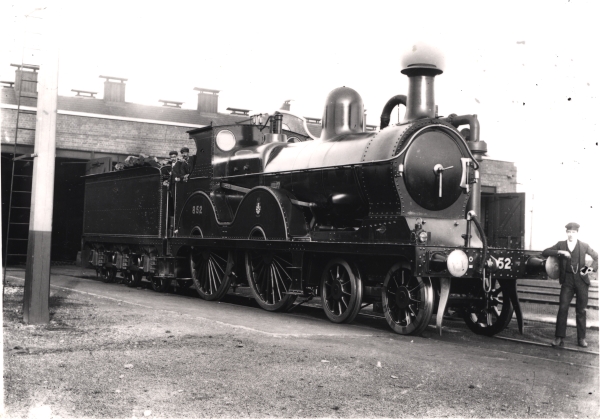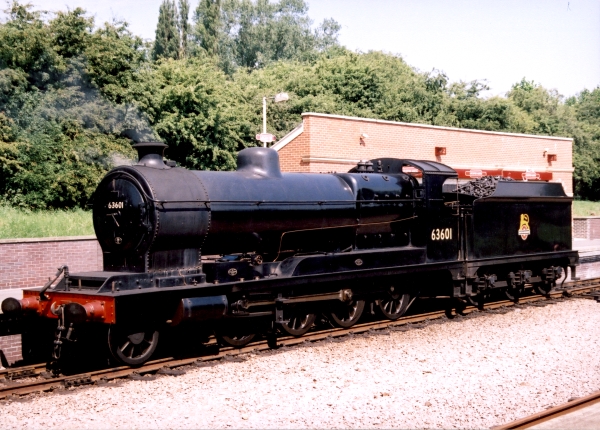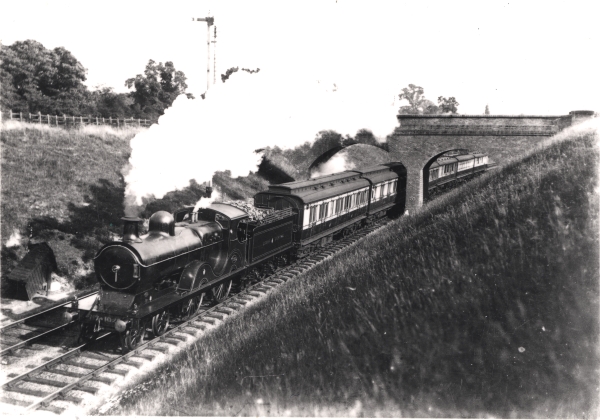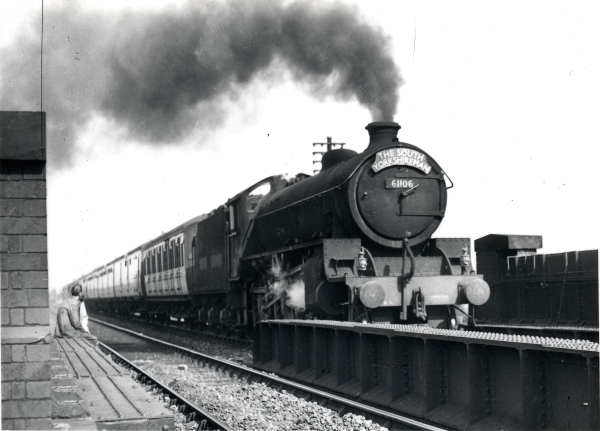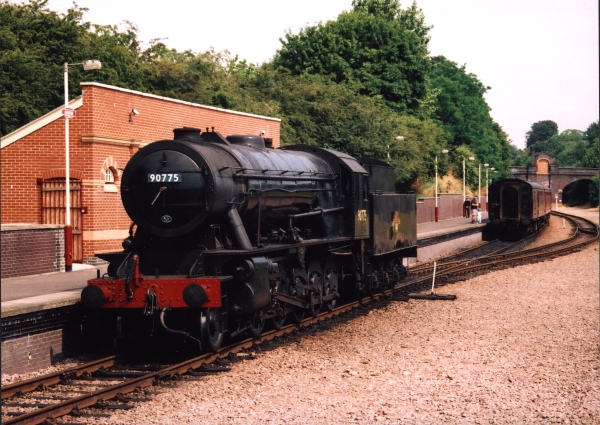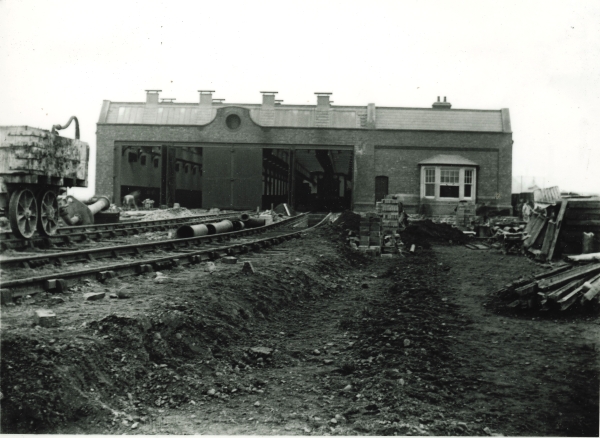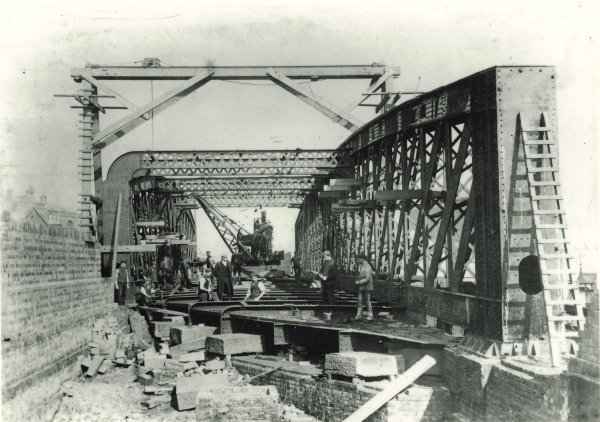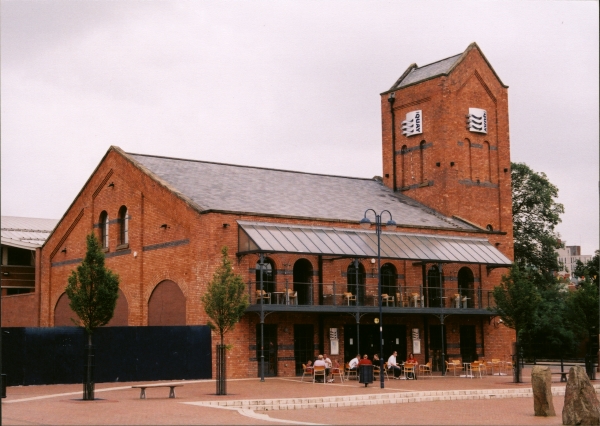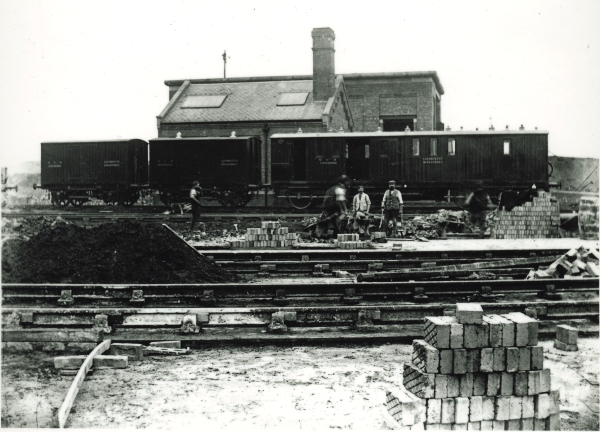The War Years on the GCR
I have a LNER 'Stock book' covering the approximate years of 1941 - 46; I would have been about twelve years old when I wrote out all that information and it was not an uncommon task for train mad lads in those days - there were also three other companies to do!
We got most of the information from Ian Allen spotters books which were our bible and later might join a locomotive society as I did; this would give information on movements and, perhaps more sadly important at that time, the scrapping of many elderly locos which had been kept on during the war years.
Photographed outside the shed at Woodford, this handsome engine is the 4-4-0 Class 11A main line locomotive No. 852, designed by Harry Pollitt in 1897 and later modified by John Robinson. See Details
Living in Briton Street (West End) in sight of the G.C. I was lucky enough to see many of the splendid locos of the 'Robinson era'. He designed most of the engines to be seen on the Central from 1923 onwards including the beautiful 'Atlantic's' (4-4-2) known as 'Jersey Lillies'. My class record in the Stock Book shows that I managed to see all but two of the 26 locos, all at Leicester and several were in fact 'shedded' at Leicester Locomotive Power Depot.
Many locos had names which I always found fascinating such as the 'Directors' class D11 with its ' Gerard Powys - Dewhirst' - what an imposing name. 'Butler Henderson' which survived and actually ran on the present G.C. in the nineties until its firebox began leaking and is now a static exhibit at the National Railway Museum in York requiring a vast amount of money for restoration.
Great Central Railway, 8B class 4-4-2 'Atlantic' type locomotive, No. 1085. It was designed by GCR Chief Mechanical Engineer John G. Robinson and was one of a batch of five built for the company by the North British Locomotive Co. of Glasgow. See Details
The other surviving Robinson is a class 04, 2-8-0, freight locomotive, we called them 'Rods' because many of them saw service with the Railway Operating Division during the Great War. The survivor was restored at Loughborough after a great effort by readers of 'Steam' magazine to find necessary funding and I can see it from my front window overlooking the deep railway cutting at Birstall trundling by most weeks - isn't that great?
Class 8K (later O4) heavy freight 2-8-0 which was introduced in 1911. This particular example is the last survivor of the type in this country. The locomotive is part of the National Collection but is on loan to the Great Central Railway in Loughborough where it carries its British Railways livery and number 63601. See Details
Robinsons and Thompsons
This quite magnificent photograph is thought to have been taken around 1905 near Birstall, Leicester. Running at speed along the cutting is a Robinson designed 4-4-0 Class 11B main line passenger engine of 1901. See Details
Among all of the Director's names is a Robinson Class B3 called 'Valour', this was often to be seen at Leicester and had a magnificent nameplate which commemorated the members of staff of the G.C.R. who lost their lives in the Great War. I believe that the tradition was very recently revived when a new diesel locomotive was given the name with due ceremony. One class fondly remembered that was not a Robinson was the graceful Atlantic (4-4-2) designed by Ivatt of the Great Northern, these came mainly from Grantham or Lincoln but were regularly seen on fast passenger and later fitted freight trains. They had such fine lines and some were rebuilt by Nigel Gresley and I have always thought they influenced his later designs like the Pacific's (e.g. Flying Scotsman).
B1 class 4-6-0, No. 61106, designed by Edward Thompson (the London & North Eastern Railway's Chief Mechanical Engineer) as a mixed-traffic work horse. The class proved to be both successful and popular. See Details
Unfortunately the end of the Second World War and subsequent Nationalisation was the wholesale demise of most of those splendid locos, Thompsons 4-6-0 B1 class known as 'Springboks' were already to be seen at Leicester. During the war we had 'the Yanks' but what we spotters knew under this name were the U.S. Army austerity locomotives which were powerful 2-8-0s with a very distinctive noise. It is generally forgotten that they were quite numerous for a short while. I notice from my Stock Book that I 'copped' nineteen of them and they were used for general freight duties, not just for army movements; there is at least one preserved and this guested last year on one of the Great Central's wartime weekends. There were also smaller American tank engines, some of which were seen at Leicester depot.
The equivalent British locomotive was the 'Austerity' 2-8-0 and 2-10-0 which was very straight forward and easily serviced, large numbers were seen on the Central and both types are preserved.
The new Great Central Railway is one of the country's leading preserved lines, and as such is host to many large locomotives. One such visitor was this former War Department 'Austerity' 2-10-0 locomotive. See Details
Trainspotting days
At the end of Briton Street where I lived was the river and over this was a footbridge which many railway workers used every day, particularly to reach the extensive carriage sheds which were opposite. There were long raised platforms so that the carriages could be washed down and cleaned without requiring ladders and these still remained until recently. I was evacuated to Leicester from Leigh-on-Sea in Essex so I found it pretty noisy with the trams rumbling down Narborough Road on one side (they ran pretty late) and the railway on the other (all night!) but as I boy I loved all the sounds. By the way, on New Years Eve all the locos sounded off their whistles but nobody seemed to mind
An interesting view of the nearly completed Leicester Central engine shed, captured sometime around 1899. See Details
Briton Street meets Western Road and further up that road was an entry leading to the ' Black Pad', a cinder path which ran along the backs of the houses all the way down to where the Midland Burton line crosses via a bridge. This was the Mecca for all G.C. train spotters (and others!) and in retrospect the homeowners were very tolerant as we had few complaints. Most days I would cycle from the Wyggeston Boys School, often looking in at the birdcage walk over Swain Street bridge to see what was at the L.M.S Depot and then up to the Black Pad before tea. It must have been strongly imprinted on my mind because one day I came off my bike and got a thump on the head; this was on Welford Road hill yet the next thing I remember was asking my spotter friends where I lived! Yes, I had somehow got to the Black Pad from whence they took me home.
The run into Leicester Central Station from the north and south involved the crossing of a 'bowstring' lattice girder bridge. From the north, trains would have to cross Northgate Street Bridge, and trains from the south would have to cross Braunstone Gate Bridge - seen here under construction circa 1897. See Details
Anyway, the Yanks. The American forces were so friendly and generous. There were often several complete trains full of soldiers held up on the main line in the evening as traffic was so heavy and they were often alongside the Black Pad. The usual 'Got any gum chum?' rang out and they would throw packets of gum and sweets to us from the carriage windows; they liked to talk and ask us about England, we thought they were all film stars.
Taken from Bede Meadows in July 2002, this photograph shows the old Great Central Power House which is now a pub called 'The Quay'. The building, once a part of the old Leicester South goods yard, is only one of two ex-GCR structures that still stand on the old goods yard site. See Details
The Black Pad
There was always plenty to interest us on the Black Pad, the possibility of a rare loco from another region or 'copping' the last of a class you'd been waiting for, occasionally a bit of banter with the railwaymen who generally put up with us. There were exceptions though and we were not particularly welcome around the Depot area which was approached via a gap in the railings by the canal footpath.
Bridge 378 carrying Upperton Road in Leicester looking west. The two-arch skew bridge looks to be complete, but there is a pumping engine spilling water into the river on the left. See Details
The very few serious addicts who owned a camera (if only!) were treated better, such as Horace Gamble of Ratby who amassed a wonderful collection of the local scene at that time. Inevitably there were a very few older lads who got up to some irresponsible tricks. There was a resident shunting engine always present opposite the Black Pad, a little J69 tanker known for some reason as 'Banny' and one crew appeared to take a dislike to a few lads and would shout derisory remarks. Anyway, there was a shunter's hut opposite and somehow several detonators disappeared from thence; these were small explosive devices which could be clipped to the lines to indicate an emergency. Well one foggy evening 'Banny' returned to her waiting siding and set off a number of explosions much to the consternation of the crew and the signalman in the adjacent box (he would normally be responsible for setting detonators).
Upperton Road bridge crossed the London Extension and its sidings at Leicester Goods Yard. The main line itself passed beneath the double girder span visible to the left of the central iron section. Under construction in the foreground is the wagon repair shop, one of the few Great Central buildings that still stands today. See Details
Generally though we younger lads were well behaved although there was the diversion of putting half pennies on the rails of the Burton line which made them penny size and a four inch oval nail became a quite handy throwing knife!
Some of us became fairly 'serious' spotters and I visited many Depots and Works if I could obtain an official pass. They were happy days and I am reminded every time a preserved train passes along the old Great Central.
Paul Tansley 4th March 2004
View of the locomotive servicing facilities nearing completion at Leicester. The main locomotive shed would have been behind the photographer and slightly to the left. See Details



